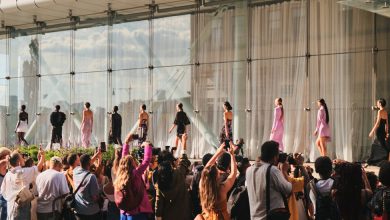Can the Rule of Three Solve All My Dressing Problems?

I’ve recently started watching YouTube videos about creating capsule wardrobes. Several of the presenters mention the “rule of three” (colors), but they don’t do a good job explaining the concept. For instance: I wear my glasses all day, every day, and they have brown frames. Does that mean brown is always one of my three colors? Does jewelry count as one of the three colors? Finally, what about a garment with a multicolor print? Help! — Helen, Bronxville, N.Y.
There are actually many and varied rules of three in the world. Why? Because, as “Schoolhouse Rock” told us all in 1973, “three is a magic number.” It is the smallest number required to create a pattern, and patterns are how humans process information.
People love triads. We have three branches of government, three witches in “Macbeth,” three body paragraphs in the classic five-paragraph essay to make an argument. The holy trinity. The three wise men. The Three Stooges, the three bears. I could go on.
As the Romans said, “omne trium perfectum.” Which translates as, “everything that comes in threes is perfect.” That may be taking it a bit far, but you get the idea.
Speechwriters have their own rule of three, which involves rhetorical repetition. See Lincoln’s Gettysburg Address, which went in part: “We cannot dedicate, we cannot consecrate, we cannot hallow this ground.” “Government of the people, by the people, for the people.” So do mathematicians, whose rule of three has to do with solving linear problems in which three variables are known and the fourth is not.
My personal favorite rule of three has to do with trend identification: one example of anything is a fluke, two is a coincidence, three is a trend. But the rule of three you cite is, I believe, derived from color theory and states that the most effective design involves no more than three colors at any one time (black and white not included, since they are neutrals). Ideally they are used in the following proportion: 60 percent primary, 30 percent secondary, 10 percent accent. This rule is used in cinematography, interior decorating and, yup, fashion.
But in fashion the interpretation is pretty loosey-goosey. Some people, for example, apply it to wardrobe building or packing, essentially adhering to the idea that if you work with the same three colors, you can mix and match them more efficiently and effectively. This is true; I do it for fashion week travel.
Others use it to plan daily looks. Steve Jobs did it by wearing the same thing pretty much every day: black turtleneck, bluejeans, white sneakers.
But still others say it is a load of hooey. Anna Piaggi, a brilliant Italian Vogue fashion editor and famously idiosyncratic dresser, never stuck to three colors in her life. She favored more like 30 at once.
If you do want to test the concept, the best approach may be to use the rule of three as a general guideline. When it comes to print, pick the dominant background color as one shade; accessories are your accent color. (Eyeglasses do not count.)
And despite those Romans, remember: When it comes to fashion, most rules are made to be broken.
Your Style Questions, Answered
Every week on Open Thread, Vanessa will answer a reader’s fashion-related question, which you can send to her anytime via email or Twitter. Questions are edited and condensed.





